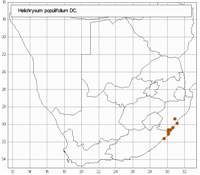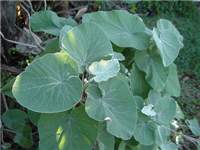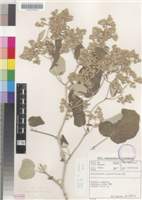Common names:
Poplar Helichrysum
Origin of name:
populi = poplarfolium = leaved
Diagnostic characters:
Leaves large, not sessile, bicoloured, hairyMedium sized headLarge open inflorescence
Description:
Soft-wooded shrub up to 2 m tall and as much across, branches white-felted, leafy. Leaves on white-felted petioles up to 70 mm long, blade up to c. 130 x 110 mm, broadly ovate or subrotund, apex obtuse, base cordate, upper surface cobwebby, glabrescent, lower white-felted, digitately nerved. Heads homogamous, campanulate, c. 3 x 2 mm, in small clusters arranged in very large divaricate panicles terminating the branchlets. Involucral bracts in 4�5 series, graded, imbricate, outer pale brown, woolly, inner with opaque white obtuse tips equaling the flowers, minutely radiating. Receptacle conical, minutely tuberculate. Flowers 16�24. Achenes 0.5�0.75 mm long, with duplex hairs. Pappus bristles many, slightly exceeding corolla, tips barbellate, bases cohering lightly by patent cilia.
Flowering between February and May.
Distribution:
Grows on large outcropping masses of rock or along the cliffs above gorges, up to c. 800 m. Apparently confined to Table Mountain Sandstone formations from the Noodsberg NW. of Durban south to Port St Johns in the Transkei.
Savanna, Grassland and Thicket Biomes.
Notes:
The large poplar-like leaves make this a most distinctive species.
Taxonomy:
Literature:
Helichrysum populifolium DC.,Prodr. 6: 180 (1838); Harv. in F.C. 3: 229 (1865); Moeser in Bot. Jb. 44: 289 (1910); Hilliard, Compositae in Natal 207 (1977).
Type:
Cape, between the Umzimkulu and Umzimvubu Rivers, Dr�ge 5010 (G-DC, holo.; BM; P; S, iso.).
Synonym(s):
Gnaphalium populifolium (DC.) Sch. Bip. in Bot. Ztg 3; 170 (1845).
Vouchers:
Galpin 2848 (PRE); Hilliard & Burtt 10237 (E; K; M; MO; NU; S); Strey 8106 (K; NU; PRE).


